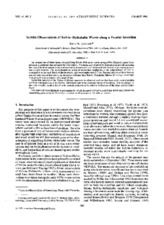| dc.creator | Nielsen, John | |
| dc.date.accessioned | 2016-10-28T17:18:46Z | |
| dc.date.available | 2016-10-28T17:18:46Z | |
| dc.date.issued | 1992-03-01 | |
| dc.identifier.citation | Nielsen, J. W., 1992: In situ observations of Kelvin-Helmholtz waves along a frontal inversion. J. Atmos. Sci., 49, 369-386. | en |
| dc.identifier.uri | https://hdl.handle.net/1969.1/158212 | |
| dc.description | © Copyright 1992 American Meteorological Society (AMS). Permission to use figures, tables, and brief excerpts from this work in scientific and educational works is hereby granted provided that the source is acknowledged. Any use of material in this work that is determined to be “fair use” under Section 107 of the U.S. Copyright Act September 2010 Page 2 or that satisfies the conditions specified in Section 108 of the U.S. Copyright Act (17 USC §108, as revised by P.L. 94-553) does not require the AMS’s permission. Republication, systematic reproduction, posting in electronic form, such as on a web site or in a searchable database, or other uses of this material, except as exempted by the above statement, requires written permission or a license from the AMS. Additional details are provided in the AMS Copyright Policy, available on the AMS Web site located at (https://www.ametsoc.org/) or from the AMS at 617-227-2425 or copyrights@ametsoc.org. | en |
| dc.description.abstract | An unusual set of observations of amplifying Kelvin-Helmholtz waves along a New England coastal front inversion is presented and compared to linear theory. The waves were observed by instrumented aircraft traversing the coastal front at various levels and measuring temperature and horizontal and vertical wind components at one-second intervals. The most prominent group of waves had amplitudes in the neighborhood of 100 m, comparable to the total depth of the inversion, and wavelengths near 1.7 km. Spectral analysis of data from an aircraft pass located just above the inversion indicates that Kelvin-Helmholtz billows of 1−2-km wavelength were present over a distance of at least 25 km.
Numerical solution of the Taylor-Goldstein equation for observed and specified basic-state vertical profiles confirms that instability of the Kelvin-Helmholtz type is the dominant mode of instability. The wavelength of the most unstable mode is found to be strongly sensitive to the relative thicknesses of the shear and inversion layers.
The observed waves illustrate a mechanism by which dammed cold air is eroded and accelerated toward the mountains, particularly as the ambient onshore wind increases or the cold air warms. | en |
| dc.description.sponsorship | National Science Foundation | en |
| dc.language.iso | en_US | |
| dc.publisher | American Meteorological Society | |
| dc.subject | Kelvin-Helmholtz | en |
| dc.subject | coastal fronts | en |
| dc.title | In Situ Observations of Kelvin-Helmholtz Waves along a Frontal Inversion | en |
| dc.type | Article | en |
| local.department | Atmospheric Sciences | en |
| dc.identifier.doi | 10.1175/1520-0469(1992)049<0369:ISOOKH>2.0.CO;2 | |


